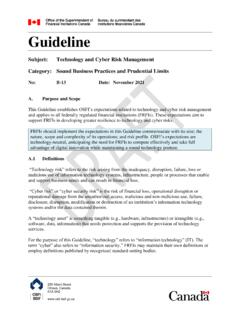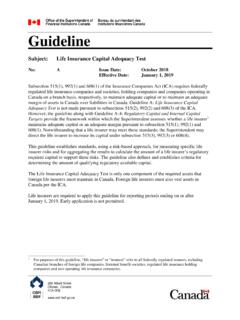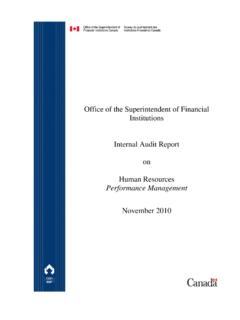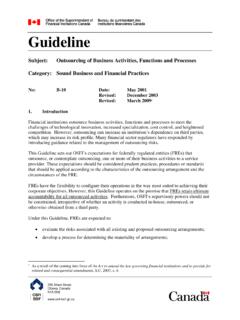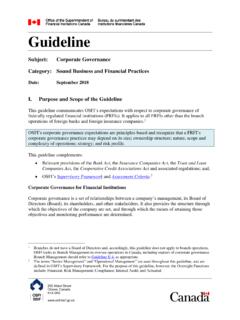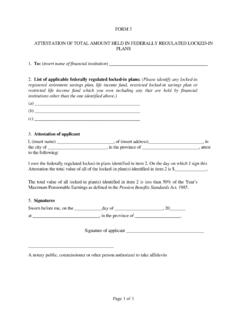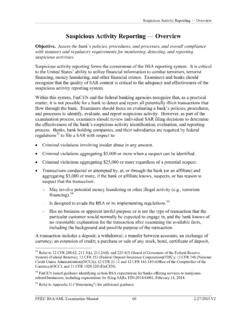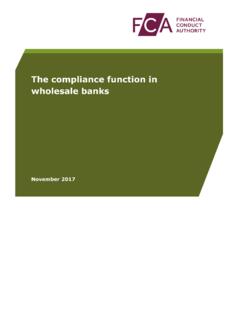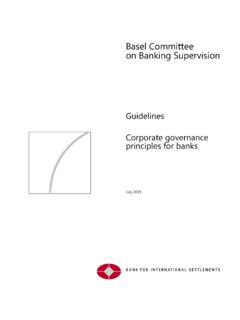Transcription of Guideline E-13 - Sound Business & Financial Practices
1 255 Albert Street Ottawa, Canada K1A 0H2 Guideline Subject: regulatory compliance Management (RCM) (formerly Legislative compliance Management (LCM)) Category: Sound Business & Financial Practices No: E-13 Date: November 2014 I. Purpose and Scope of the Guideline The purpose of the RCM Guideline is to communicate OSFI s expectations with respect to the management of regulatory compliance risk by federally regulated Financial institutions (FRFIs)1. This Guideline revises and replaces the 2003 LCM Guideline to better align it with guidance provided by more recently updated OSFI Guidelines2, and complements OSFI s Supervisory Framework and Assessment Criteria.
2 The Guideline also elaborates on a number of principles regarding key controls as part of RCM. OSFI recognizes that FRFIs may have different RCM Practices depending on a variety of factors, including their: size; ownership structure; nature, scope and complexity of operations; corporate strategy; risk profile; and geographical locations. 1 FRFIs are defined as banks, authorized foreign banks, trust companies, loan companies, cooperative credit associations and retail associations, domestic and foreign life insurance companies (including fraternal benefit societies) and domestic and foreign property and casualty insurance companies.
3 FRFIs operating in Canada on a branch basis should read references in this document to Senior Management as references to Branch Management. 2 For example, OSFI s Corporate Governance Guideline published January 2013. Banks/FBB/T&L/Coop/Life/P&C regulatory compliance Management November 2014 Page 2 of 9 Table of Contents I. Purpose and Scope of the Guideline ..1 II. III. RCM Framework Overview ..3 IV. RCM Framework ..4 (i) Role of the CCO ..5 (ii) Procedures for Identifying, Risk Assessing, Communicating, Managing and Mitigating regulatory compliance Risk and Maintaining Knowledge of Applicable regulatory Requirements.
4 5 (iii) Day-to-Day compliance Procedures ..5 (iv) Independent Monitoring and Testing Procedures ..6 (v) Internal (vi) Role of Internal Audit or Other Independent Review Function ..8 (vii) Adequate Documentation ..8 (viii) Role of Senior Management ..8 V. OSFI s Supervisory Assessment ..9 Banks/FBB/T&L/Coop/Life/P&C regulatory compliance Management November 2014 Page 3 of 9 II. Definitions (i) regulatory compliance Management (RCM) The term regulatory compliance Management (RCM) in this Guideline refers to the set of key controls through which a FRFI manages regulatory compliance risk. (ii) regulatory compliance Risk For the purposes of this Guideline , regulatory compliance risk is the risk of a FRFI s potential non-conformance with laws, rules, regulations and prescribed Practices ( regulatory requirements ) in any jurisdiction in which it operates.
5 It does not include risk arising from non-conformance with ethical standards. regulatory requirements are applicable to the FRFI or a subsidiary worldwide that require the FRFI or subsidiary to do (or prohibit it from doing) certain things or to act or conduct its affairs in a particular manner. (iii) RCM Framework A RCM framework refers to the structures, processes and other key control elements through which a FRFI and its subsidiaries manage and mitigate regulatory compliance risk inherent in their activities enterprise-wide3. III. RCM Framework Overview OSFI considers an effective RCM framework to be an essential component of an overall risk management program that provides the means by which a FRFI satisfies itself it is in compliance with applicable regulatory requirements.
6 Non- compliance with applicable regulatory requirements can have significant negative effects on a FRFI s reputation and/or safety and soundness and may lead to increased regulatory intervention. The RCM framework should enable a FRFI to apply a risk-based approach for identifying, risk-assessing, communicating, managing and mitigating regulatory compliance risk. The framework should also include a definition of regulatory compliance risk appropriate for the FRFI. Overall responsibility for assessment and management of regulatory compliance risk within the FRFI should be assigned to an individual who is independent from operational management, has sufficient stature, authority, resources and support within the FRFI to influence the FRFI s activities, and who should be designated, at least functionally, as the FRFI s Chief compliance Officer (CCO) or equivalent.
7 Although most FRFIs will have a dedicated CCO position, OSFI recognizes that this individual may have other responsibilities as well, especially in the case of small, less complex FRFIs. 3 Enterprise-wide means throughout all Business activities applicable to the FRFI and its subsidiaries world-wide. The expectations in this Guideline apply on an enterprise-wide basis. OSFI recognizes that internationally-active FRFIs may have to tailor global methodology to suit local environments. Banks/FBB/T&L/Coop/Life/P&C regulatory compliance Management November 2014 Page 4 of 9 Staff assigned to compliance responsibilities, including the CCO, should have the appropriate skills and knowledge of the Business and regulatory environments that are essential to effective RCM.
8 See further, Role of CCO, below. OSFI assesses the quality of RCM at the following levels of control: operational management4 for a given Business activity which is primarily responsible for the controls used to manage the regulatory compliance risks within the activity on a day-to-day basis; and independent, enterprise-wide oversight of operational management by oversight functions5&6. OSFI expects the RCM framework to be reviewed and updated regularly, at least annually, to address: any need for improvement, new and changing regulatory compliance risk, new Business activities and any changes to corporate structure.
9 The review methodology should include a mechanism that holds individuals or areas accountable for their assigned duties or functions. OSFI will administer its RCM supervisory program in a manner appropriate to the circumstances of each FRFI. Each FRFI, regardless of the size, is expected to have risk management controls that are proportionate to its identified risks. IV. RCM Framework Key controls, including oversight functions, are the basic elements of a Sound RCM framework. At a minimum, OSFI expects the RCM framework to include the following, administered through a methodology that establishes clear lines of responsibility and a mechanism for holding individuals accountable: (i) role of the CCO; (ii) procedures for identifying, risk assessing, communicating, effectively managing and mitigating regulatory compliance risk and maintaining knowledge of applicable regulatory requirements; (iii) day-to-day compliance procedures; (iv) independent monitoring and testing procedures; (v) internal reporting; (vi) role of Internal Audit or other independent review function.
10 (vii) adequate documentation; and (viii) role of Senior Management7. Each of these items is described in further detail below. 4 Operational management should satisfy itself that FRFI line staff understand the regulatory compliance risks inherent in the activity and that policies, processes and resources are sufficient and effective in managing those risks. Senior Management is responsible for overseeing the implementation of the RCM framework. 5 As stated in the Supervisory Framework, there are seven oversight functions that may exist in a FRFI: Financial ; compliance ; Actuarial; Risk Management; Internal Audit; Senior Management; and the Board.
